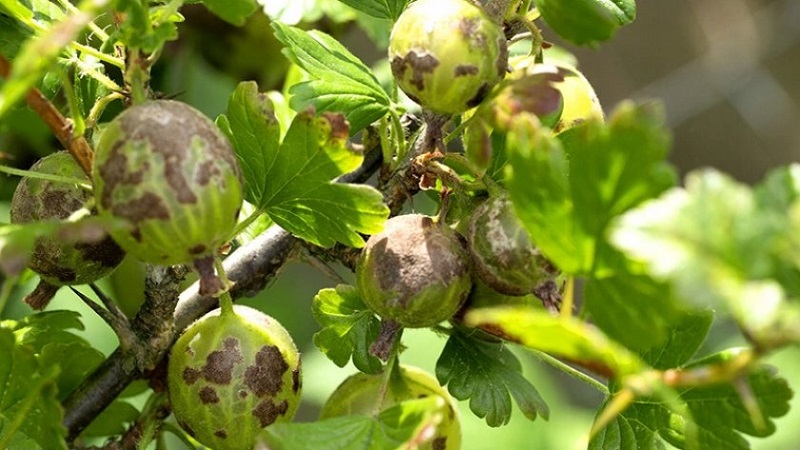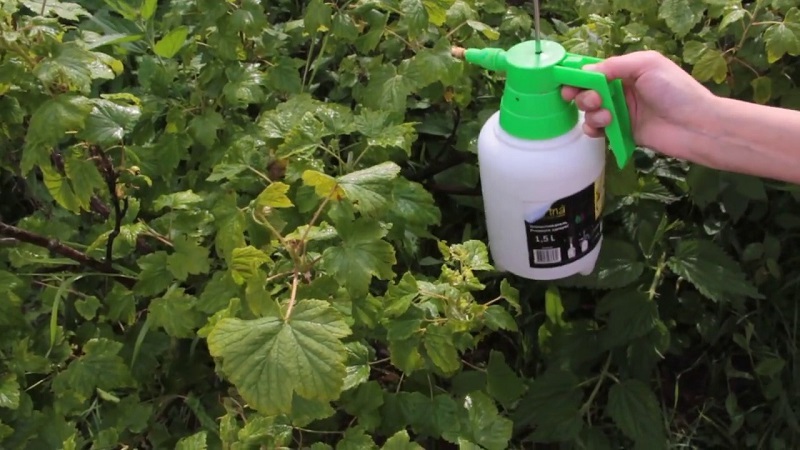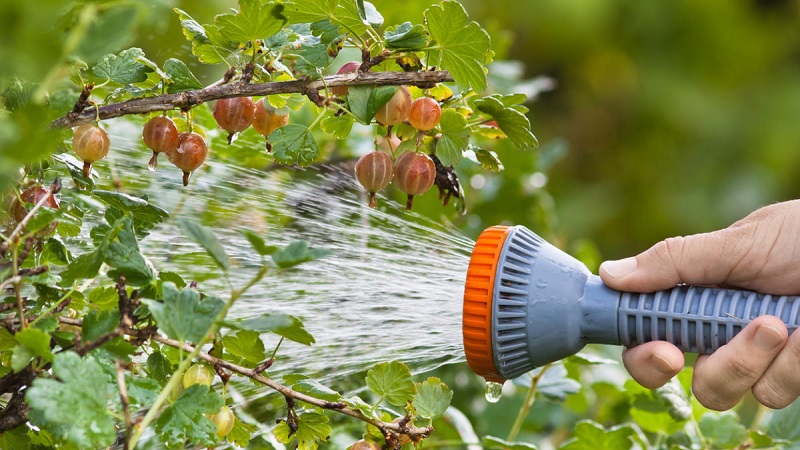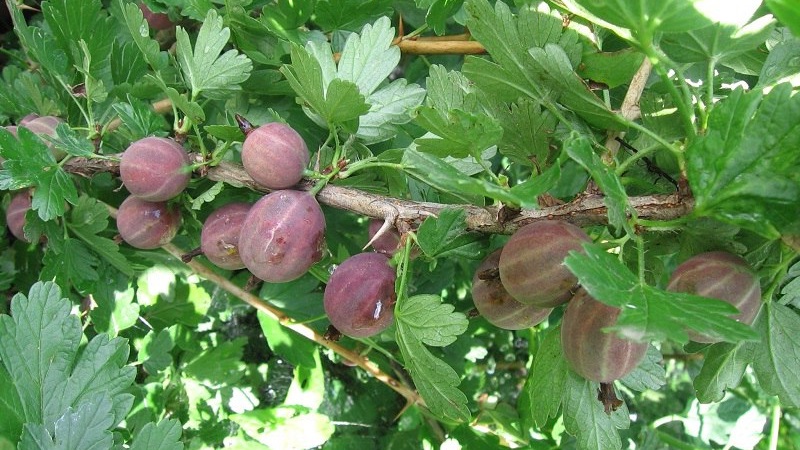How and what to treat gooseberries from scab: the most effective methods of combating the disease
A disease called scab often affects gooseberries. Fungal spores are small in size and easily carried by the wind, so protecting the plant is very difficult. How to treat gooseberries from scab and what preventive measures will help protect the crop from death, we will tell in the article.
The content of the article
What is this disease
Scab is a fungal disease that spreads rapidly throughout the plant. in conditions comfortable for the reproduction of the fungus.
She is often confused with powdery mildew... The differences lie in the fact that the causative agents of powdery mildew are not marsupial fungi, like in scab, but erysiphoid, or powdery mildew.
What is dangerous for gooseberries
Scab disrupts the process of photosynthesis in gooseberries, affects and destroys berries, which leads to a sharp decrease in yield indicators.
With a strong infection, shoots suffer, due to which nutrients enter the plant in small quantities, and due to lack of nutrition, the gooseberry dies. Bushes weakened by scab may not survive the cold winter or bloom in the spring, making it impossible to harvest at the end of the season.
Spread
Microscopic fungi are carried by the wind or on the wings and legs of pests... With a strong thickening of gooseberry bushes, the disease spreads faster with watering or precipitation: drops flow down the leaves, bounce off the soil and reach new shoots and bushes.

Signs of infection
Scab manifests itself on fruits, leaves and shoots gooseberry.
From external signs they note:
- peeling of the skin of berries;
- brown fruit stains (ranging from light shades to dark brown-brown burns):
- warts on leaf plates and shoots.
The leaves are the first to suffer... Velvety spots appear on them with a focus in the center of the leaf plate. After the spores mature, they grow and change color from light to rusty.
After that, the disease turns into berries.... The shape of the fruit changes, they crack, which allows spores to penetrate into the pulp. The bacteria dry out the inside of the berry, leaving only dry skin.
The last stage is the defeat of the shoots... Spots appear on them, the stems are deformed and stop growing. The nutrition of the plant is disrupted, after which the bush cannot be cured, and the gooseberry dies.
Causes, causative agents of the disease
The causative agents of scab are pathogenic microscopic fungi known as ascomycetes, or marsupial fungi. They move easily through the air and multiply rapidly in suitable conditions, namely:
- if the soil moisture is increased on the site as a result of frequent watering or prolonged precipitation;
- when watering, the foliage of plants gets very wet, moisture flows down the shoots to the roots and stagnates there;
- keeps high air humidity at a temperature of + 12 ... + 27 ° C;
- profuse dew, fog, rain in the morning;
- the thinning of the shoots was not carried out in the gooseberry, the foliage is strongly thickened;
- on the site there is an invasion of pests moving between plantings;
- the bushes were planted after black currants or other gooseberry varieties.
Treatment methods
Scab is easy to cure in the initial stages of manifestation.... For this, various methods are used, which together give good results.

Folk methods
At the initial stage of the disease, when the first external signs appear, and the scab has not spread throughout all the gooseberry bushes, use folk remedies:
- Mullein solution. 1 part mullein is mixed with 3 parts of water and infused for 3 days. Then the bushes are sprayed, at least 2 times, with a break of 7-10 days.
- Ash solution. For 10 liters of water take 1 kg of ash. After thorough mixing, the solution is infused for a week, after which it is used to spray the bushes 1 time in 2 days until the signs of the disease disappear.
- Soda and soap. 50 g of laundry soap is rubbed and diluted in 10 liters of water. Add 40 g of baking soda. The solution is used twice: before flowering and after flowering.
- Manganese sulfate. A universal remedy used by gardeners as a top dressing, for preventive purposes and as a way to fight scab at the initial stage. For this, a 1.5-2% solution is made, with which gooseberries are treated during the entire growing season, once every 3 weeks.
Agrotechnical techniques
Protect the plant from scab and stop its spread over the plantings agrotechnical techniques help:
- carry out regular weeding of the soil around the gooseberry, remove fallen leaves, branches and stones;
- when sick shoots are found, they are removed, and the cut sites are sprinkled with wood ash or moistened with a weak solution of potassium permanganate;
- not allowed thickening of bushes, it is important that the air passes freely between the branches and shoots, dries moisture;
- produce regular wateringcorresponding to the gooseberry variety;
- provide timely protection of gooseberries from pests, using insecticides, vinegar solution, tobacco fumigation, mustard infusion (insects carry fungus on their legs and wings);
- follow the fertilization schedule for gooseberry varieties;
- prophylactically treat bushes with copper sulfate or other copper-containing agents.

Biological preparations
Biological products are safer than chemicals, but their effectiveness is much lower, therefore several treatments are required throughout the season:
- Copper sulfate. 20 g of copper sulfate and 70 g of crushed laundry soap are diluted in 5 liters of water. Spraying is carried out once a week, in damp weather - every 3-4 days.
- Bordeaux mixture. 100 g of copper sulfate is diluted in 1 liter of water. Lime is slaked separately in the same proportions. The resulting solutions are poured into 6 liters of water and spraying is carried out at the same frequency as indicated above.
Chemicals
Recommended chemical products:
- "DNOC" (10 ml per 10 l of water), in early spring;
- arsenates (10 g per 15 liters of water), before the berries appear;
- "Akreks" (10 g per 10 liters), during the rest period, in autumn and spring;
- "Karatan" (10 g per 10 l), during the rest period, in spring and autumn;
- "Nitrofen" 125 (12 g per 10 l), in the spring before the buds appear.
Spraying is carried out early in the morning or in the evening under the weather conditions specified in the instructions for the preparation.
Features of the struggle during flowering, fruiting, dormancy
Chemical preparations cannot be used during the flowering period., because they will scare away bees, and gooseberries will not form ovaries. In this case, the scab is treated with folk remedies.
They are also used during the fruiting period, if the disease manifested itself less than a month before picking berries. If the fruits are still far from ripening, gardeners use chemicals that will completely wash off the surface of the fruits at the right time, or active substances harmful to the human body will undergo a decay period.
In the resting stage, gooseberries can be processed with both biological products and chemistry, and folk infusions and solutions.
Getting rid of scab on berries, leaves, branches
When spraying gooseberry bushes with the selected solution or preparation, make sure that the liquid got on all parts of the plant and soaked the soil of the trunk circle well. This allows you to destroy the mycelium and reduce the likelihood of relapse.
In dry weather, spraying is carried out every 7-10 days, and at high humidity - 2 times more often.
Bushes that have suffered from scab very much, it is better to dig up and burn outside the site., and sprinkle the soil with boiling water and sprinkle with wood ash. A solution of potassium permanganate is also suitable.
Scab-resistant gooseberry varieties
Varieties that are not afraid of scab and powdery mildew:
- Neslukhovsky;
- Lefort (photo below);
- Spring;
- Houghton;
- Malachite;
- Ural grapes;
- Blackie;
- African;
- Negus;
- Russian yellow and Russian red;
- Isabel;
- Gingerbread man;
- Salute.

Preventive measures
Prevention is an effective measure of scab control. It is about the processing of bushes in spring and autumn, already after harvest.
The risk of a gooseberry scab infection is reduced if every spring, until the planting buds awaken, treat with a 7% urea solution. Spraying is carried out in the early morning or evening after sunset. The liquid should completely wet all parts of the plant and moisturize the soil under it well.
In the fall, fallen leaves are raked and taken out of the site, where they are burned with the rest of the plant debris. The trunk circle is dug up, after which the urea is again used according to the scheme described above.
Conclusion
Scab is a common problem faced by gardeners who grow gooseberries on their site. However, timely detection of the initial signs of the disease allows you to save the harvest and save the garden from death.
Use combined methods of treatment, do not neglect agrotechnical methods of growing crops and prepare for the new season in the fall.